
 USS Virginia, Texas, Mississippi, Arkansas (1971)
USS Virginia, Texas, Mississippi, Arkansas (1971)US Cold War Cruisers:
Worcester | Des Moines | Juneau | Boston | Galveston | Providence | Albany class | Long Beach | Leahy | Belknap | Bainbridge | Truxtun | California | Virginia | Ticonderoga | Strike Cruiser (CSGN)These four ships planned at first as fleet escorts (frigates) like the previous California class, were requalified “cruisers” in 1975 when entering service. USS Virginia (CGN-38), started in August 1972 was commissioned in 1976, and USS Texas, Mississippi and Arkansas (CGN 39-41), between 1977 and 1980. They were designed as more economical than the california, and to operate along with the new Spruance class destroyers. They were however wider and heavier than the California, with two dual role SAM/ASW standard/ASROC launchers, 5-in quick-firing guns, and triple ASW Mk.46 Torpedoes launchers. They had no facilities for helicopters however while their ASW capabilities remained hampered by the noisy cooling pumps from their D2G reactors.
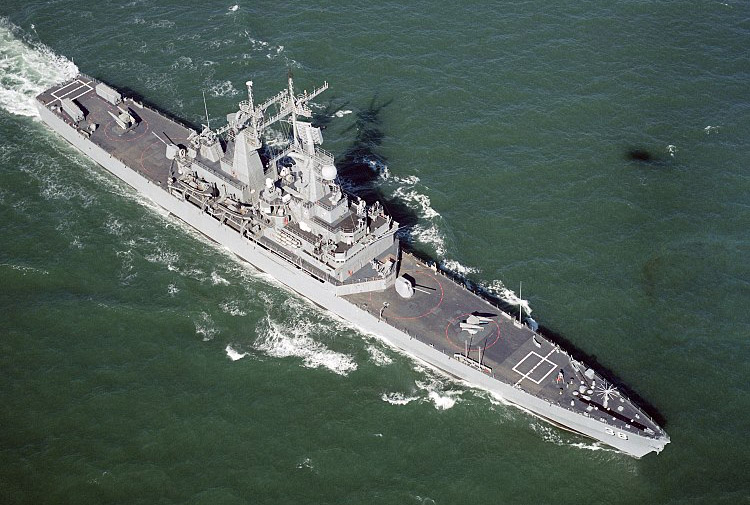
They were however the first to use the new SQS-53A sonar and associated Mk116 fire control system. Their nuclear powerplant was improved as each stop to rload their core was woth ten years of service. In the 1980s they were modernized with the SM-2 missiles, Kevlar protection, eight Harpoon anti-ship missiles and eight Tomahawks installed on their aft deck, while the helipad was removed. In 1990-95, they received the new NTU system, abandoned ASROC missiles, gained the SPS-49 and 48A radars, two Phalanx missile guns. Costly, they were however decommissioned in the context of post-cold war budget cuts, in 1993-94 and 1996-97 for the two pairs. All four were disposed off at the Ship-Submarine Recycling Program at Bremerton.
Development
The Virginia class started as a derivative from the earlier California-class (CGN-36) with three of these new cruisers authorized as “guided-missile frigates” but re-stated as cruisers during construction. The fifth CGN-42, was canceled (see later). But deeper within, they came from the 1960s discussions about the advantages of an all-nuclear battle group, center around new aircraft carriers such as USS Enteprise. This came back from 1966 joint recommendation of five congressional committees for the armed services, appropriations and joint committee to go for nuclear powered escorts. On 3 February 1967 Rickover pushed the case further by a study of the comparative advantages of an all-nuclear CBG versus a conventionally powered one. His observaitons went to Paul H. Nitze, secretary of the navy at the time.
As Rickover puts it:
“No matter how many tradeoffs we study of other ways to spend the money we need to pay for nuclear propulsion, we will always be faced with comparing unlike things; none of the tradeoffs accord freedom from logistic support for propulsion fuel which is provided by nuclear propulsion. The other tradeoffs provide additional defense protection to the CVAN, but none of them increase the offensive capability of the CVAN as well—as does nuclear propulsion in the escorts. To compare a larger number of conventional escorts with a smaller number of nuclear escorts at equal cost is not to compare alternate ways of achieving the same capability; it is merely to compare two different capabilities that can be achieved with the same amount of money.”
Based on this remaining funds for USS South Carolina (sister ship for California) and full funds for a second frigate which became USS Virginia, DLGN 38 were granted to at leat study the DX/DXG ships. The resulting DLGN 38 ended in late 1938 when presented by BuShips as 20 feet shorter, 3 feet wider, 200 tons heavier as the Californias.
At the time, they were double enders sitll armed with Mk 26 launchers for SM-1s but controlled by two Tartar D missile fire control systems. Also there was an aft helicopter facility with helideck and spot with refulling post, but no hangar.
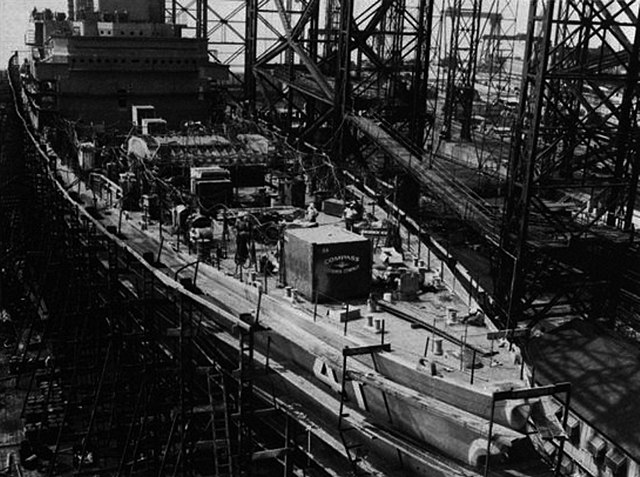
All along the new computer-based command and control system ASMS (later AEGIS) was worked out, but dragged on compared to the design advances made on the new ships, but efforts were made to reduce displacement at no more than 10,000 tons. In 1969 the design evolved and thanks to the space freed aft, one SH-2 LAMPS helicopter wich housing below deck hangar aft could be realized as well as associated magazines, stowage, and ammunition. For this, engineers dusted off the detailed plans for the aft section of the WW2 Baltimore class. The elevator platform was also the helispot, and brough the helicopter below while the parture was closed by light sliding doors.
Good on paper, in practice it was not brillant as unproper sealing of the hatches leaked heavily so much so that constant freshwater washdowns alternated with drying phases were necessary.
Also other details of the design were improved, such as the bow trim problems resolved by replacing the keel-stowed anchor by a bow-stowed anchor. And the bow flare was increased to clear the protruding AN/SQS 53A bow sonar.
As for armament, the elimination of the separate ASROC forward and replacement by two twin-rail “universal” missile launchers for AAW (ASROC) and SM-1 were truly a simplification but they kept two 5-in/54 for AAW and ASUW, the ASW capability being completed by a LAMPS helicopter with all facilities. Later upgrades with the Tomahawk, Harpoon, Standard SM2(MR) System and new radars and EW systems brought them up to the best standards of the time in the 1980s. The Mk.26 launcher was even capable of launhing the Harpoon, and could fire all types in rapid succession whatever the sea conditions were. Before the introduction of the VLS, they truly were and advantage over the California class.
What was new about this Mark 26 was its modular design, enabling the entire launcher and its vertical rotating carousel simply “plugged in”, resting on prepared foundations within the ship. Again before the VLS, this provided an enormous amount of flexibility. The rest of the design was pretty mish standard, with two triple TT banks of the usual 324 mm Mark 48 acoustic torpedoes.
Compared to the Tartar/Terrier, the SM-1, albeit using the old style continuous rod warhead, had a new fuse whose with sensing cones and digital electronics allowing a far greater accuracy and insentivity to countermeasures while being able to destroy any targets, ship, aircraft or missile. After their 1980s upgrade, they basically had a triple bubble of anti-ship defence (SM-2, Harpoon, Tomahawk).
Design of the class
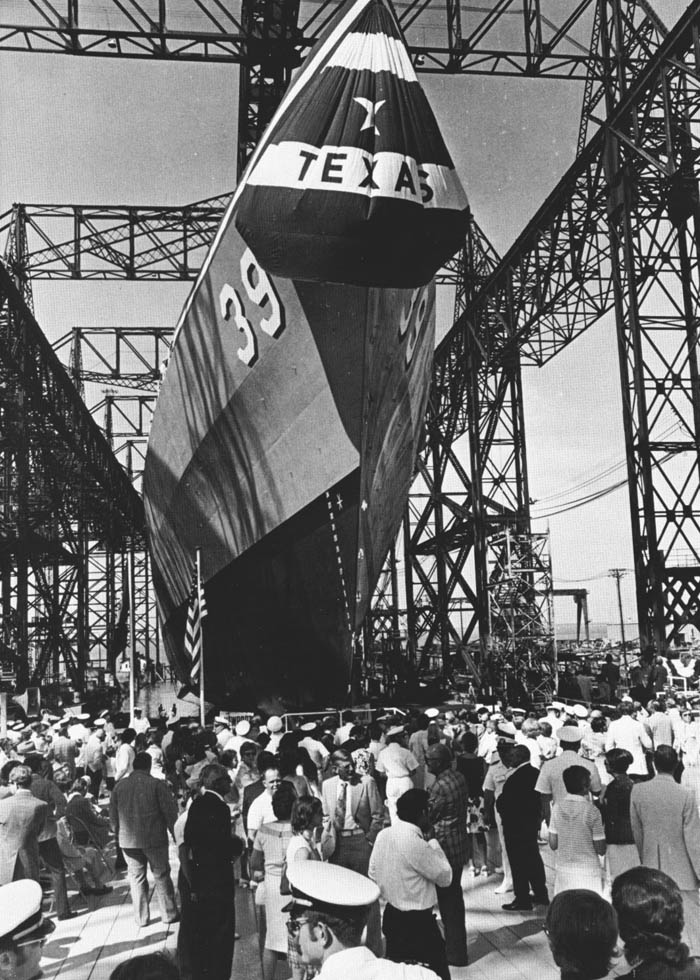
Hull and general design
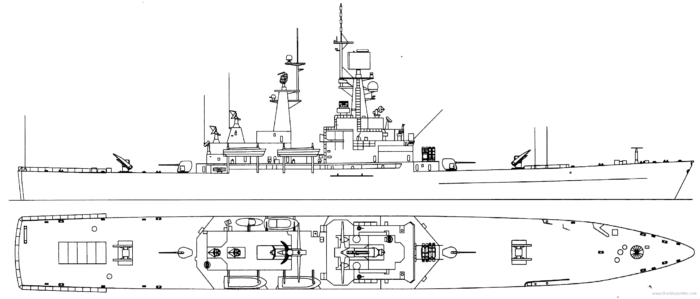
Compared to the California class, the Virginia were slightly shorter, they displaced a bit more however at 10,663 long tons (10,834 t) standard and 11,666 long tons (11,853 t) fully loaded, for an overall length of 586 ft (179 m) overall (vs. 587 ft), and 63 ft (19 m) in beam like their precedessors, ahd had a larger draft at 32 ft (9.8 m) max versus 31 ft 6 in (9.60 m).
They shared however with their precedessors a long fore and aft deck spaces, to accomodate in order a SAM launcher forward, folloed by a single 5-in gun at the foot of a more compact superstructure, less obviously shaped in two islands. The fore structure of th bridge was topped with an admiral deck completed by flagship facilities. They had two masts or unequal eight supporting sensors, both of a new prismatic shape, four faced, and a narrower shot supersructure with the servive boats arranged on davits either side. The superstructure represneted 1/3 of their whole lenght, so more compact than the California’s. Still, internal facilities were revised. They had a crew of 39 officers, 540 enlisted, compared to 40 officers and 544 enlisted on the Californias, so only a small reduction.
They also had superb facilities to act as flagship facilities which was found very handy as they were used in their career often as flagships. Mostly they were used as master air-defense ships, but could equally act anti-submarine warfare and surface-to-surface warfare (SSW) command ships, as well as using gun and missile bombardment on shore targets.
Powerplant
The Virgina class started with the same powerplants as the California class, just improved. These were two General Electric D2G nuclear reactors, passing their power via gerucros and a transmissions to two shafts for a total output of 60,000 shp (45,000 kW). The “D” in the name is associated with “destroyer”, and they were a 2nd generation. G standing for General Electric. They were common to the Bainbridge, Truxtun, California, and Virginia classes, and would have been installed on the new Strike cruisers if appropved, but they were never installed again in any USN ships.
Each D2G reactor had a max thermal output of 148 megawatts (198,000 hp), so far more then the given figure. They basically superheated steam passed onto classic geared steam turbines driving two shafts. Final ouput in shaft was between 30,000 and 35,000 horsepower (22,000 and 26,000 kW). These reactors needed a compartmentation larger than their own bulk of 37 feet (11 m) in lenfght and 31 feet (9.4 m) in width. Placed amidships they weighed 1,400 tonnes (1,400 long tons; 1,500 short tons) which was substantial. Like boilers rooms of old, they had each their own successfive compartments, fore and aft of the hull. Reactors on the California class ships were replaced by 165-megawatt (221,000 hp) D2W reactors in the 1990s but thei sisters Virginia never had the changce and were decommissioned even before their first core refill. They had no funnels and thus a reduced infrared signature.
To speed was over 30 knots (56 km/h; 35 mph) nominal, but as all nuclear powered ships, pushing the reactors to their limits would produce a top speed in excess of 35 knots or beyond.
Range of course was unlimited. Despite their cost, the major value of thse four ships was their capability of steaming at high speeds and act as escorts for the fast nuclear-powered aircraft carriers. They became a familiar sight for all Nimitz class CBG (Carrier battle groups), but served also with John F Kennedy and Enterprise.
Armament
2×2 SM-1 standard
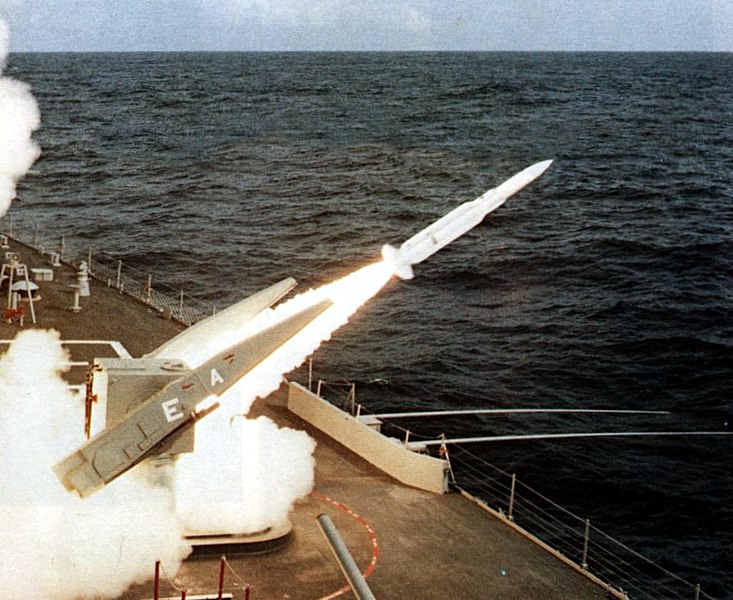
Two single systems, 80 RIM-66 in storage total. The RIM-66 entered service in 1967 so as these cruisers were about to be launched. The RIM-66A is a medium replacement for the Tartar and considered one of the “Standard” missiles derived from the RIM-24C/Mk74 “Tartar” Control System. Same fuselage as the Tartar to be retrofitted on existing launchers and magazines. The RIM-66A/B had redesigned electronics, a more reliable homing system, better fuze. Thus led to the SM-1MR Block I to V making its combat drbut at the very end of the Vietnam War. The latest was the RIM-66E (SM-1MR Block VI), no longer in service.
The first version of 1967 became in production the Block IV (1968) while I-III were prototypes. Block IIIs were also upgraded to Block IV, with better ECCM improvements and still the Tartar Mk 27 rocket motor, and shorter than later versions.
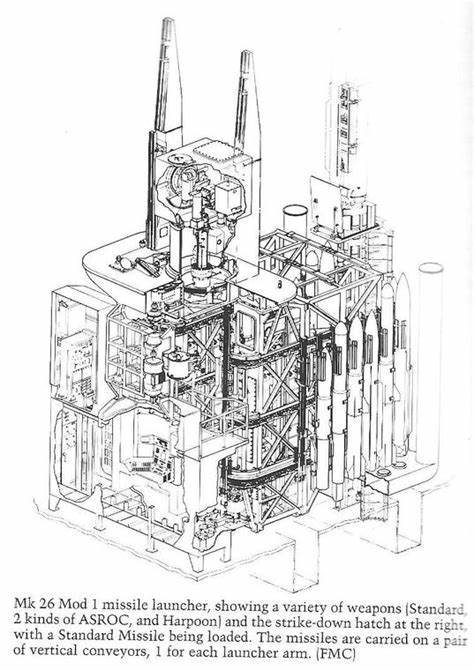
The Mark 26 Mod 1 missile launcher showing in succession an SM-2, ASROC and Harpoon in its carousel (FMC).
The two systems enable to launch a pair of missiles every 9 seconds, or 4 missiles total in that timeframe, which is pretty close to modern VLS, which had their drawbacks. Indeed, if the launcher has to point directly at the target on a determine firing arc, the missile had an immediate course, whereas from a vertical tube, the missile has to “tip over” first and then proceeded to course. A delay which is not unsubstantial. Plus to avoid too much interference, some time is given even between VLS launches.
⚙ specifications RIM-66 |
|
| Weight | 562 kg |
| Dimensions | 4.22 x 0.34 x wp 1.07 m |
| Propulsion | Solid propellant, Aerojet MK 27 Mod 4 dual thrust motor |
| Speed | Mach 2 |
| Range | Range 32 km, Altitude 19.8 km |
| Guidance | Semi-active radar homing Seeker, Conical scan passive radar |
| Warhead | MK 51, 62 kg Continuous rod |
2×1 5-in/54 Mark 42 DP
The “universal” 5-Inch/54 Mark 42 gun, 127 mm saw two, for the first time, installed on a nuclear cruiser. It enabled dual purpose fire (air targets past SAM range) or for surface and ground warfare. Fully automatic, dual-purpose, 40 rounds per minute rate of fire and a large array of ammunition, HE, fuse Frag, smoke and exercize round. There was a single one close to the base superstructure and another aft of it.
⚙ specifications 5-in/55 DP |
Turret size | 9.652 m (31 ft 8.0 in) |
| Turret Weight | 60.4 long tons (61.4 t) |
| Barrel | 6.858 m (270.0 in, rifling 5.82 m (229 in) |
| Recoil | 18.75 inches (476.2 mm) |
| Elevation/Traverse | -15°/+85°, rate 25°/sec – 150° from either side centerline, rate 40°/sec |
| Shell | 127 x 835mm .R 31.75 kg (70.0 lb) |
| Muzzle velocity | 2,650 ft/s (807.7 m/s) |
| Rate of fire | 40 rpm automatic original down to 28 rpm 1968 |
| Range (surface) | 25,909 yd (23,691.2 m) at +45° elevation |
| Ceiling (AA) | 51,600 ft (15,727.7 m) at +85° elevation |
| Guidance | Mark 68 gun fire control system with AN/SPG-53 radar |
2×3 TTs 14-in Mk48
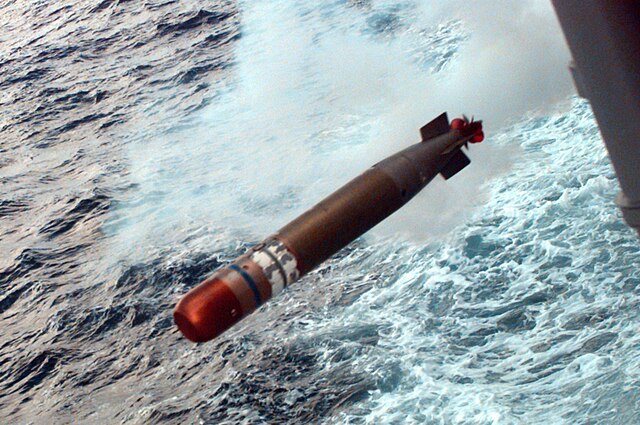
Mark 46 torpedo being launched.
⚙ specifications Mk.46 TORPEDO |
|
| Weight | 259 kg |
| Dimensions | 2.59 meters x 0.324 m |
| Propulsion | Otto Solid fuel turbine motor, twin propeller |
| Range/speed setting | 35 kt at 7.5 km, max depth 350 m |
| Warhead | 45 kg Mk 103 Mod 0 warhead, PBX filling |
| Guidance | Active/passive acoustic seeker 460 m homing range |
Sensors
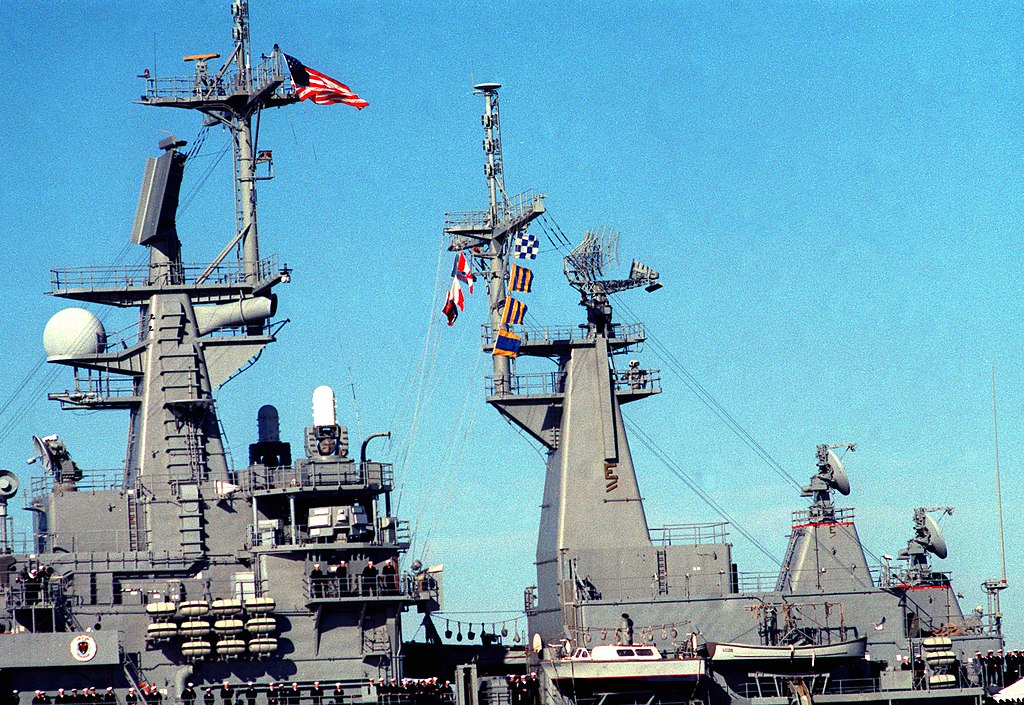
Details (explanations, D. Mitch)
AN/SPS-48E 3-D air search radar:
AN/SPS-49 2-D air search radar:
AN/SPS-55 surface search radar:
AN/SPQ-9A gun fire control radar:
AN/SPG-60 fire control radar:
AN/SPG-51 missile fire control radar:
AN/SQS-26 bow mounted sonar:
Protection
Passive Protection
It was set in place in the 1980s overhauls of the class, but originally, there were only a comprehensive ASW compartimentation against torpedo flooding as in past designs.
The passive protection upgrade did no called for heavy steel but instead lighter 1 inche (25 mm) Kevlar plastic armor panelling. These were installed around the combat information center (CIC), the ammunition magazines, and the machinery spaces. Note that by their very nature, the reactor core are under a very thick containment cell and also well protected against any incoming projectile.
Active Protection
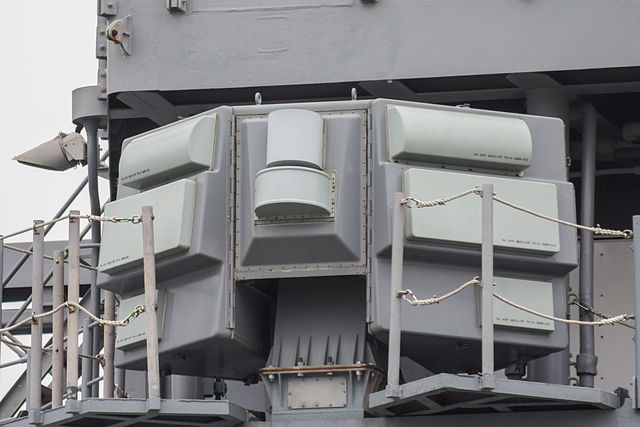
It revolved around three systems, that is, before the introduction of NTU (New Threat Upgrade), see later.
AN/SLQ-32:
A single set, installed as the (V)3 which had added antennas with electronic attack capability to actively jam targeting radars and anti-ship missile terminal guidance radars.
Mark 36 SRBOC: BAE Systems Mark 36 Super Rapid Bloom Offboard Countermeasures Chaff and Decoy Launching System, “Super-arboc” short-range decoy launching system firing radar or infrared decoys at incoming anti-ship missiles. They were interfaced with the AN/SLQ-32 electronic warfare suite.
AN/SLQ-25 Nixie:
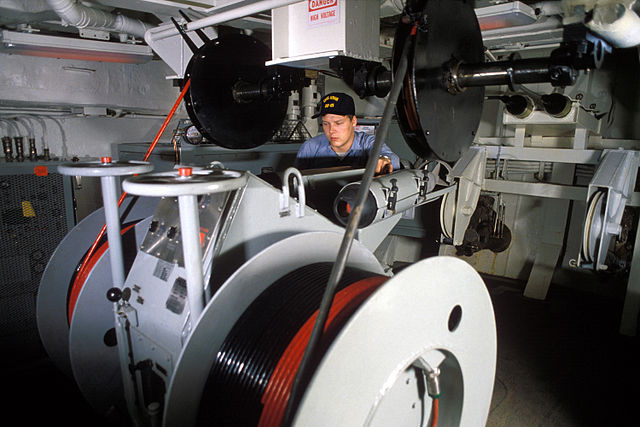
The standard anti-torpeo defence decoy, TB-14A. The latter defated the incoming torpedo’s passive sonar, emitting simulated propeller and engine noise as well as countering the torpedo’s active sonar by amplifying and returning its pings. Mounted in the stern, operated in pairs.
Air Group
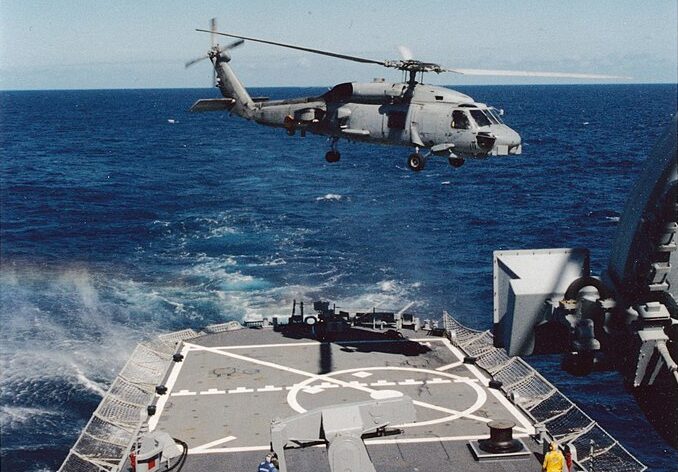
Sikorsky SH-2 Seahawk taking off the aft helideck from USS California.
The two cruisers came with the “capability” to operate a helicopter for short time and given missions, usable for SAR, liaison and ASW patrols if needed, initially the LAMPS III Kaman SH-2 Seasprite, later the SH-60 Seahawk until the end of their career. No hangar means poor serviceability.

Illustration of the Virginia class cruisers
⚙ specifications |
|
| Displacement | 10,300t(10,663 long tons) standard, 11,000t FL (11,666 long tons) |
| Dimensions | 586 x 63 x 32 ft (178.3 x 19.2 x 6.4/9.8 m) |
| Propulsion | 2 shafts GS turbines, 2x D2G reactors, 60,000 hp (45,000 kW). |
| Speed | 30 kn+ (56 km/h; 35 mph) |
| Range | Unlimited, supplies 90 days |
| Armament | 2×2 SM-1 standard/ASROC (68), 2×2 3-in AA/AM, 2×3 TT 14-in side (14 mk32) |
| Passive Protection | 1-in Kevlar CIC, magazines, machinery spaces |
| Sensors | SPS-40, SPS-55, SPG-51, 60, SPQ-9. Sonar SQS-53 |
| Active Portection | |
| Air Group | ASW helicopter HH-60 Seahawk |
| Crew | 519 |
Modernization

In the 1980s, the four cruisers at different dates received the ‘New Threat Upgrade’ (NTU) which was a major electronics overhaul to better face modern threats. They had the upgraded twin arms launchers Mk 26 setup to fire the Standard SM-2MR medium-range surface-to-air missile, repolacing the Mk 10 launchers required manual fitting of the missile fins before launch, and no longer the case. With their “short” magazines and Mk 26 launchers they could not fire the longer range SM-2ER however, only the more restricted SM-2MR. They however received a considerable long range strike capabilitoes against ships and land targets with a set of Tomahawk cruise missile armored box launchers installed in lieu of their LAMPS helicopter. This was due to the problematic elevator and below-deck hangar. They were supposed to sail together with the helicopter capable Spruance class which had better ASW capabilities anyway, but they paled in comparison of the later Ticoderoga class cruisers one main reason of their removal from service (see below).
Succession: The CGN-42 strike cruisers concept

Under this name, by number the the fifth ship of the Vriginia class, the program started on 1975 as work on the future AEGIS system was carried out. Eight strike cruisers were planned, with a far larger hull (17,284 tonnes fully loaded, 216 m or 710 feet long) and the upgraded pair of D2G General Electric nuclear reactors. The program evolved aroubnd new features such as the massive new 8-inches 55 caliber gun MCLWG forward, but trials dragged one while costs rose exponantially. Key features included a new stepped hull with tal aft-midship bulwards, a stepped configuration, single island and massive lattice mainmast plus twi hangar and a helideck after, as well as extra launchers aft. The greater lenght was an obligation to stay a “double ender” while having this full LAMPS III helicopter capability. It was cancelled at the end of the Ford administration after anotehr revision in 1977.
It resurfaced as a conversion of a fifth cruiser of the Virginia class then cancelled again in 1983. This seemed a more economical approach, however at the time, the Ticonderoga class seemed more promising, based on the conventional Spruance class destroyers. Projection of construction and maintenance cost made them appear twice as cheaper as a single Virginia class.
There were more programs still revolving around the idea later of a capital ship with Aegis; The 1995 Arsenal ship for example was destined to replace the Iowa class battleships with a massive array of missiles in VLS (vertical launchers). They were designed around the idea of saturation fire over any target, mostly a land one.
The DD21 was the former SC-21 (Surface Combatant for the 21st century) which led to the Zumwalt design, changed named but was terminated in 2001. It was the product of an engineering think tank, Group Mike to see how the use of VLS could revolutionize the shape and functionalities of a ship. It also planned railguns and lasers. But apart the Zumwalt, which only three were ever built, the Destroyer Variant (DDV) program of December 1991 first intended as a stopgap was further developed as the Arleigh Burke-class destroyer. It should be recalled that the post cold war context was not favourable to built new cruisers, apart those of the Ticonderoga, which were decommissioned earlier than anticipated.
The CG(X) is a more recent program, for a 20-25,000 displacement ship (19 planned) planned for 2017. Called the Next Generation Cruiser program, this was research program to develop a replacement vessel for the 22 Ticonderoga-class cruisers in service back in 2002. In 2017 however, the Chinese Navy was ramping up its capabilities and as of today, the USN only has 13 of the “Tico” operational, but no replacement in sight. This made the Virginia class the last true “cruisers” in the USN, perhaps ever. Perhaps the incoming threat of a full scale war in the China Sea will change things, as for now, the Pentagon analyst estimated the Type 055 destroyer, largest Chinese PLAN vessels (in reality cruisers in disguise) are more or less equivalent to the “Tico” and there is no emergency need for a better class.
Assessment
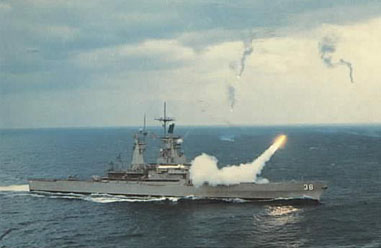 All four ships were decommissioned by the early 1990s, after 16 to 18 years of service, sacrificed on the altar of the “peace dividend” post-Cold War. This was an early retirement for ships quite costly to built and designed for a service life of 38 years. The factor here to blame was a general lack of resources, with all branches U.S. military facing major budget cutbacks and competing for what remained. As usual, this is a match the USAF seemed to win. No consideration was even given to have them mothballed, in reserve.
All four ships were decommissioned by the early 1990s, after 16 to 18 years of service, sacrificed on the altar of the “peace dividend” post-Cold War. This was an early retirement for ships quite costly to built and designed for a service life of 38 years. The factor here to blame was a general lack of resources, with all branches U.S. military facing major budget cutbacks and competing for what remained. As usual, this is a match the USAF seemed to win. No consideration was even given to have them mothballed, in reserve.
The cost of a first nuclear refuelings compounded by their mid-life overhauls as was their NTU refittings were budgeted to half the price of new cruisers. The other critical point on the long run was their large crews. The 1996 “Navy Visibility and Management of Operating and Support Costs” study brought their operating cost at $40 million versus $28 million for a Ticonderoga-class, $20 million for an Arleigh Burke class, which both featured the more capable Aegis Combat System. Early Ticonderoga-class lacking Vertical Launch Systems also left early after 18-21 years but it was less critical as the Virginia class. To compare, the Albany class missile cruisers, started in WW2 ended their career in the late 1980s, so almost half a century.
 Virginia (CGN-38)
Virginia (CGN-38)
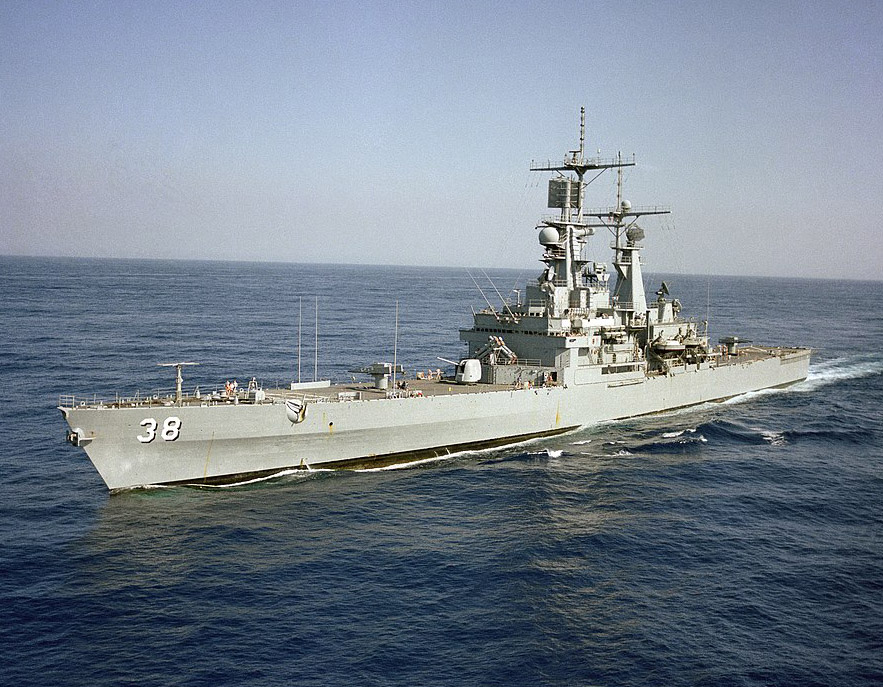
She was built at Newport News Shipbuilding & Dry Dock Company, ordered 21 December 1971, laid down 19 August 1972, launched 14 December 1974, completed 11 September 1976 with Captain George W. Davis, Jr., in command.
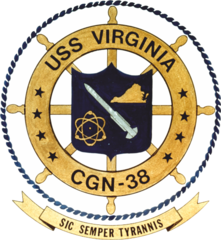 She served along the eastern seaboard and West Indies several after her shakedown cruiser and for weapons qualifications. As lead ship (motto “Sic Semper Tyrannis”), she saw many post-commissioning tests and fixes. On 25 April 1977, this was her Norfolk Naval Shipyard five-month, post shakedown availability. Final sea trials went on 28 September and she integrated at last the Atlantic Fleet for standard training. In November, she started live ASW fire exercises along New England and Newfoundland. By December she was in the Caribbean missile for life firing her SM-1 standard SAM at the range. She was back at Norfolk for upkeep. 1978 saw her from May off the Virginia Capes for local operations. On 28 January 1978 she was off the Florida coast and West Indies for special tests under the new Chief of Naval Operations and back to Norfolk on 23 March.
She served along the eastern seaboard and West Indies several after her shakedown cruiser and for weapons qualifications. As lead ship (motto “Sic Semper Tyrannis”), she saw many post-commissioning tests and fixes. On 25 April 1977, this was her Norfolk Naval Shipyard five-month, post shakedown availability. Final sea trials went on 28 September and she integrated at last the Atlantic Fleet for standard training. In November, she started live ASW fire exercises along New England and Newfoundland. By December she was in the Caribbean missile for life firing her SM-1 standard SAM at the range. She was back at Norfolk for upkeep. 1978 saw her from May off the Virginia Capes for local operations. On 28 January 1978 she was off the Florida coast and West Indies for special tests under the new Chief of Naval Operations and back to Norfolk on 23 March.
On 23 August she started her first cruise to northern Europe for NATO Northern Wedding. She visited Oslo, Norway, but also Rotterdam and Portsmouth and bac HP Norfolk on 12 October, later training in the Gulf of Mexico, stopping in Mobile for naval gunfire support training at Vieques Island (Puerto Rico). Her Mediterranean cruise started by early 1979.
She made an Indian Ocean deployment in 1980 to the Philippines for emergency Sonar dome repairs. She made a third Mediterranean campaign in 1983 off Beirut, firing close to 300 5-inch rounds in defense of the mountain town of Suk El Gharb and provided emergency assistance after the Marine barracks attack. She received awards by the 6th Fleet CiC. In 1984 she had a major overhaul, as “first strike cruiser” with Phalanx CIWS, Tomahawk, SM-2, her aft helicopter hangar/elevator removed for two Armored Box Tomahawk cruise missile launchers. By December 1990 she was deployed in the Eastern Mediterranean for Operations Desert Shield and Desert Storm. She sailed off Israel, Lebanon, and Syria and commanded a strike group with USS Spruance and the tomahawk armed USS Pittsburgh and USS Philadelphia submarines (Los Angeles class). On 22 January 1991, she fired two Tomahawk to Iraq, longest combat firing at the time and directed four other from USS Spruance and Pittsburgh.
She was decommissioned and stricken on 29 November 1994, entering the Navy’s Nuclear-Powered Surface Ship and Submarine Recycling Program on 31 March 1999.
 Texas (CGN-39)
Texas (CGN-39)
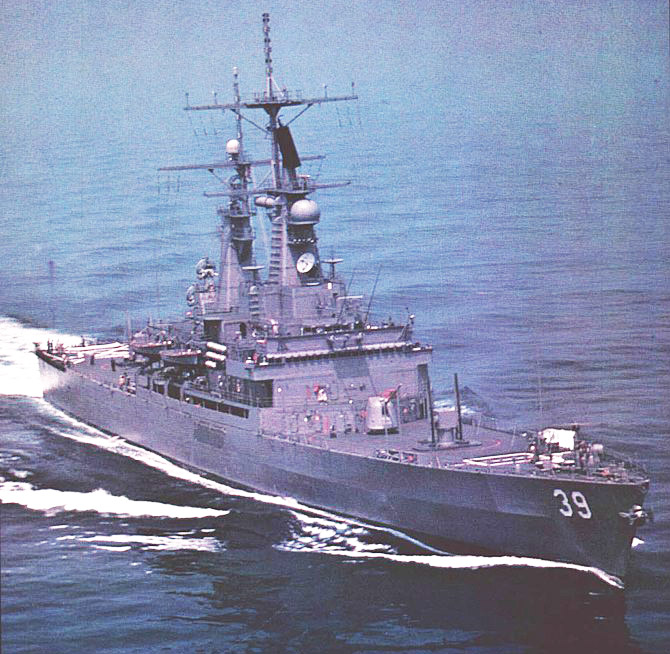
USS Texas in 1977
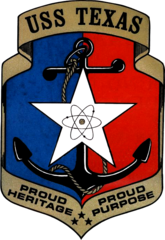 USS Texas was laid down on 18 August 1973, launched 9 August 1975, commissioned on 10 September 1977. She received the motto “Proud Heritage, Proud Purpose”. After nine-week of tests she loaded weapons at Yorktown Naval Weapons Station by October and had a refresher training off Cuba the next month. Until march 1978 she tested her propulsion and qualified all her weapons systems off the Virginia Capes and Caribbean. On 28 March she was in Post Shakedown Availability until 31 July. She later trained off the east coast down to Puerto Rico.
USS Texas was laid down on 18 August 1973, launched 9 August 1975, commissioned on 10 September 1977. She received the motto “Proud Heritage, Proud Purpose”. After nine-week of tests she loaded weapons at Yorktown Naval Weapons Station by October and had a refresher training off Cuba the next month. Until march 1978 she tested her propulsion and qualified all her weapons systems off the Virginia Capes and Caribbean. On 28 March she was in Post Shakedown Availability until 31 July. She later trained off the east coast down to Puerto Rico.
First deployment was with the USS Nimitz Carrier Battle Group (CBG) in the Mediterranean/North Arabian Sea as the Iranian hostage crisis developed and for Operation Eagle Claw. She became flagship for Cruiser-Destroyer Group One. In 1980–81 in refit she received two quad Harpoon launchers, two CIWS and returned with the Nimitz CBG in the Mediterranean. She took part in operations against Libya in the Gulf of Sidra.
On 1 March 1983 she left Norfolk on her 3rd Med TOD with the USS Carl Vinson Carrier Battle Group (CBG) and made an around-the-world cruise, arriving and homeported to San Diego. She was deployed also again in the Persian Gulf and Arabian Sea. By 1 July 1983 with Carl Vinson CBG she was in Australia and proceeded with USS Phoenix (SSN-702) to HMAS Stirling NAS, Rockingham, Fremantle and was detached from the battle group to Brisbane (14 July 1983) but while at Island Wharf, she colliding with the quay and had short repairs, proceeding to Wellington, but she was greeted on 11 August 1983 by anti-nuclear activists. She diverted to Albany, Western Australia on 29 August 1983 for R&R and departed on 1 September for San Diego. Next she was homeported to Alameda, Cal. and had a last major overhaul at Bremerton, Washington until April 1987.
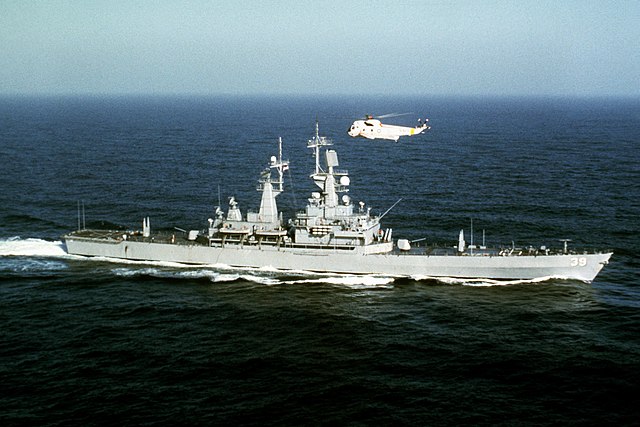
USS Texas underway with a SH-3 Sea King fying supplied on the foreground, 23 June 1985.
She was deployed with the Carl Vinson Carrier Battle Group (CBG) for Westpac 1988 and flag, Anti-Air Warfare Commander. She stopped at Singapore, Subic Bay, Hawaii, Thailand, Hong Kong and Kenya along the way. In 1989 she saw local operations, short overhaul in San Francisco and deployed in counter-narcotics operations off South America and Mexico gulf. February 1991 saw her in the Arabian Sea for her part in Operation Desert Storm as command ship, Anti-Air Warfare Commander for Nimitz CBG and base-ship for minesweeping operations off Kuwait, logistic support. She was back to San Francisco in August. In April 1992 she made another counter-narcotics deployment off Ecuador and Panama.
When she started her mid-life refueling and NTU overhaul by May 1993, decision was made to cancel al and had her placed in reserve commission instead on 31 May, then fully decom. and stricken on 16 July 1993 (15 years of service). Like her sister she entered the nuclear Ship-Submarine Recycling Program at Puget Sound Naval Shipyard by October 1999.
 Mississippi (CGN-40)
Mississippi (CGN-40)
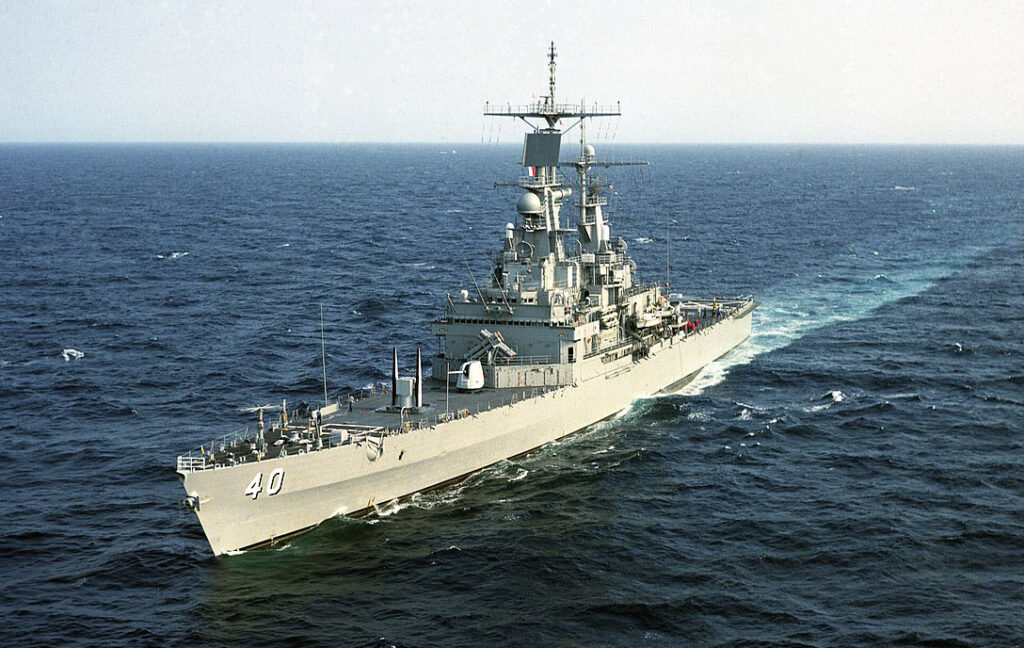
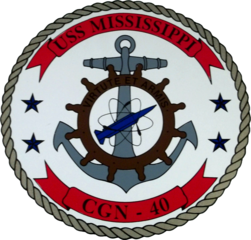 USS Mississippi was ordered on 21 January 1972, laid down at Newport News Shipbuilding & Dry Dock Co.on 22 February 1975, launched on 31 July 1976 and commissioned on 5 August 1978 at Norfolk, Virginia, ceremonies were attended by President James Jimmy Carter, Jr. SoD Harold Brown, Senator John C. Stennis of Mississippi.
USS Mississippi was ordered on 21 January 1972, laid down at Newport News Shipbuilding & Dry Dock Co.on 22 February 1975, launched on 31 July 1976 and commissioned on 5 August 1978 at Norfolk, Virginia, ceremonies were attended by President James Jimmy Carter, Jr. SoD Harold Brown, Senator John C. Stennis of Mississippi.
After her shakedown cruise to the Caribbean and South America until 13 February 1979 she started her first deployment with the Sixth Fleet and Mediterranean from 3 August 1981 to 12 February 1982, deployed in the Gulf of Sidra in Libya and Nimitz/Forrestal CBGs. She fired three RIM-66B Standard SM-1 in a live-fire exercise.
She later stayed with Nimitz and her sister Arkansas off Lebanon, assisting the Greek cargo Andalusia on 3 December 1982, vectored by a Lockheed P-3C Orion from VP-49 and asisted by two Sikorsky Sea Kings from Nimitz which transferred survivors from Mississippi herself.
On 1 August 1989 Arab terrorists in Beirut kidnapped and hanged Lt. Col. William R. Higgins of the USMC as part of the UN peacekeeping forces so USS America CBG left Singapore for the Arabian Sea, whereas USS Coral Sea came from Alexandria in a show of force, soon joined by USS Mississippi with Med 3–89 Battle Force via Haifa, Israel. She became a Coordinator for Lebanese area operations. She later took part in Pacific Exercise-89, but stayed longer in the Indian Ocean by mid-October and was back in Norfolk by November 1989.
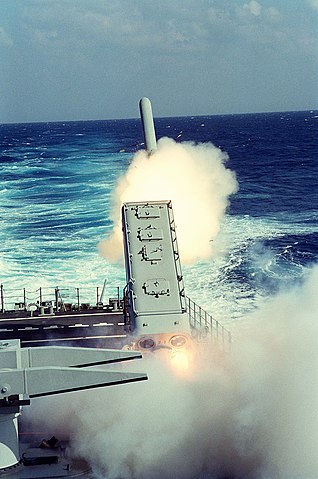 Next year she departed with John F. Kennedy CBG for Operations Desert Shield and Operation desert Storm from 16 August 1990 to 28 March 1991 and escorted USS Theodore Roosevelt at her refuelling point off the Suez Canal. They were bacl through the Bab-el-Mandeb gep to the Gulf of Aden on 15 January at break-neck speed as Yemen was close to intervene, between its shore batteries and FACs in the narrow straights. She escorted also the ammunition ship USS Nitro which had engine troubles. She was back in the northern Red Sea to fired three BGM-109 Tomahawk TLAMs at Iraqi targets on 25 January 1991, two more the following day. One failed after launch, landed in the sea. She also served as local anti-air warfare screen commander until 24 February.
Next year she departed with John F. Kennedy CBG for Operations Desert Shield and Operation desert Storm from 16 August 1990 to 28 March 1991 and escorted USS Theodore Roosevelt at her refuelling point off the Suez Canal. They were bacl through the Bab-el-Mandeb gep to the Gulf of Aden on 15 January at break-neck speed as Yemen was close to intervene, between its shore batteries and FACs in the narrow straights. She escorted also the ammunition ship USS Nitro which had engine troubles. She was back in the northern Red Sea to fired three BGM-109 Tomahawk TLAMs at Iraqi targets on 25 January 1991, two more the following day. One failed after launch, landed in the sea. She also served as local anti-air warfare screen commander until 24 February.
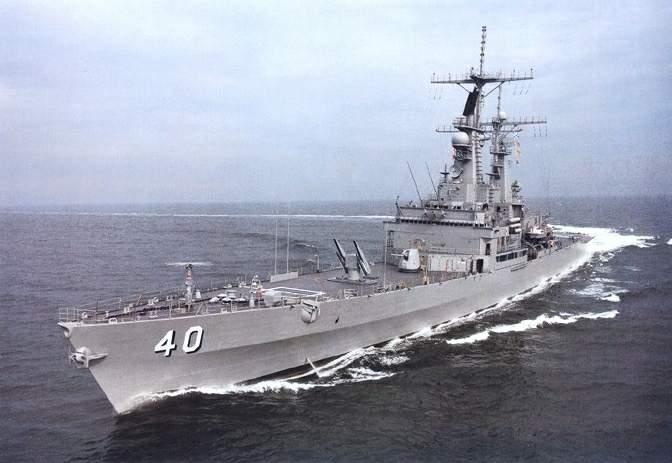
She was redeployed after the Haiti coup against President Jean-Bertrand Aristide in September 1991 under UN authorized deployments abd Operation Support Democracy, Uphold Democracy, and Restore Democracy enforcing embargoes until 3 August. The deteriorating situation by 12 September saw her escorting USS America CBG and Dwight D. Eisenhower in support of 1,800 soldiers of the Army’s XVIII Airborne Corps. It was the first operaitonal deployment of Army helicopters from a navy carrier.
USS Mississippi within NATO and the UN next started Operation Provide Promise (humanitarian relief) in former Yugoslavia from 2 July 1992 to 9 January 1996 and Operation Deny Flight policing the air space over Bosnia-Herzegovina from 12 April 1993 to 21 December 1995. Next was Operation Sharp Guard, arms embargo from 15 June 1993 to 2 October 1996 and the cruiser acted as “Red Crown” (coordinating air operations) over “Maverick” Operating Area, Adriatic from 2–18 April but also on 14–21 May, 11–21 June, 30 June to 9 July, 22–27 July, and 22 August to 6 September 1995. She intercepted the Polish Dajti, boarded as a possible smuggler on 7 April.
When two Cuban MiG-29UB Fulcrums shot down two Cessna 337 Skymasters of “Brothers to the Rescue” non-profit organization over contested international waters on 24 February 1996 USS Mississippi sailed in these Cuban waters with the guided missile cruiser Ticonderoga and frigate John L. Hall for Operations Sentinel Lifeguard, and Operation Standoff IV, in the Straits of Florida, escorting a civilian flotilla for hommage ceremonies.
By 1995 instead of having her nuclear reactors refueled plus a majo overhaul it was decided to cancel it all after 18 years of service, and CGN-40 was deactivated on 6 September 1996 at Norfolk, then decommissioned and stricken on 28 July 1997. She was to be recycled in Bremerton, Washington, carried there through Panama by the fleet tug USNS Mohawk and then USNS Navajo to the Inactive Ships Onsite Maintenance Office in Puget Sound Naval Shipyard, process started on October 2004, completed 30 November 2007.
 Arkansas (CGN-41)
Arkansas (CGN-41)
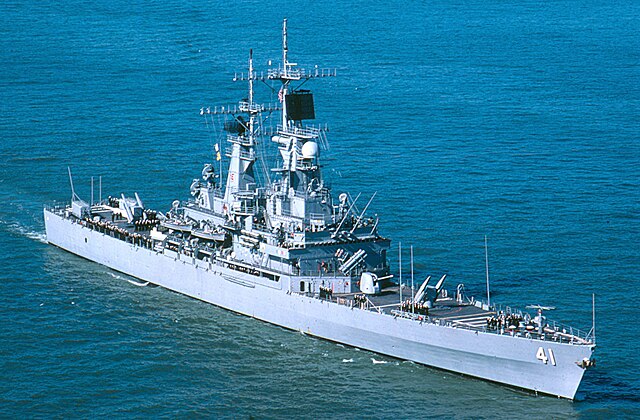
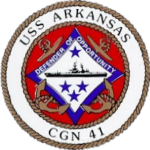 USS Arkansas was ordered on 31 January 1975, laid down on 17 January 1977, launched on 21 October 1978 and completed on 18 October 1980 under Captain Dennis S. Read in command.
USS Arkansas was ordered on 31 January 1975, laid down on 17 January 1977, launched on 21 October 1978 and completed on 18 October 1980 under Captain Dennis S. Read in command.
USS Arkansas spent her first months off Hampton Roads for port-fixes and tests and by February 1981 made her pre-shakedown trials from Puerto Rico and back after her contractor’s sea trials. She stopped at Port Everglades, followed by qualifications and certifications. On 28 April she left Norfolk for her final shakedown West Indies cruise. She went further to Rio de Janeiro and Recife and back to Norfolk on 25 June, followed by post-shakedown availability at Newport News plus upgrades on 15 December, then refresher sea trials and R&R until the end of 1981.
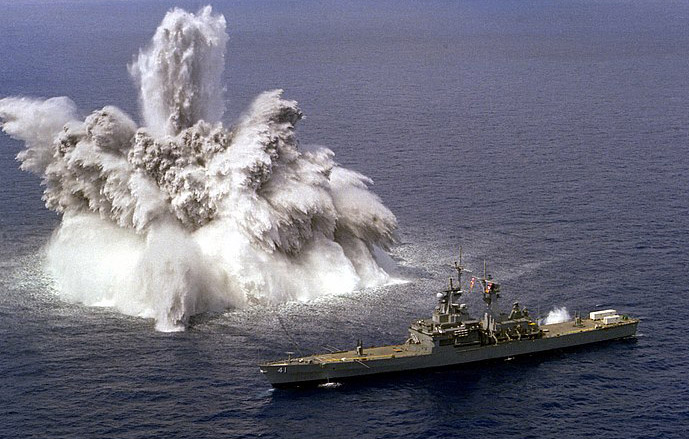
On 22 January she sailed to Key West for explosive shock tests and stopped at Mayport and Port Everglades. By early March she entered Newport News for post-shakedown fixes and new trials by 3-4 May, then 11 days of fixes. HP Norfolk on 20 May she started local operations off the Virginia Capes and West Indies, Cuba, and escorted CBG Nimitz off Puerto Rico.
On 10 November she sailed for the 6th Fleet in the Mediterranean and sailed directly to Lebanon, off Beirut on 6 December. She supported the multinational force ashore and later joined the fleet in the Gulf of Sidra, Libya. She returned off Lebanon on 4 May 1983, then headed back home via a Gibraltar visit.
On 8 July she was homeported to Alameda, and sailed there via Port Everglades, Charlotte Amalie, Canal Zone and arrived on 31 July. In September and until the end of 1983 plus six weeks of 1984 she trained in local waters and sailed to Bremerton, Puget Sound for a 3 month overhaul and back to Alameda to start a circumnavigation via Hawaii for RIMPAC 84, then Subic Bay on 20 July, Hong Kong on 6-10 August, the Indian Ocean (3 months, plus the Arabian Sea for the Iran-Iraq war) and in November, the Red Sea, Suez Canal (first nuclear powered vessel to sail it) and stopped in the Western Med at Toulon, France 7-12 November, exited Gibraltar and crossed the Atlantic via the Azores, Barbados and St. Thomas to Panama Canal on 9 December, Alameda on 17 November.
On 17-19 February 1985 she started a four-month restricted availability (Tomahawk, CIWS installed) until back HP on 25 June, for training operations until the end of 1985. On 7 December she departed and participated in exercises via Pearl Harbor, to the western Pacific, Subic Ba, Singapore, Indian Ocean to Karachi (15-20 March) and into the Arabian Sea until late April.
On 29-30 April, she transited Suez and by May-June escorted USS Enterprise CBG and guided missile cruiser USS Truxtun off Libya in support of air strikes after terrorist attacks. She stopped at Monaco and Gaeta and leaft eastwards via Suez bound for Australia arrived on 4 July for the Centennial re-dedication of the Statue of Liberty and arrived at Fremantle on 18 July, returned to Subic Bay and Pearl Harbor, 8-9 August and back home on the 13th. After leave and upkeep she started in October local operations, west coast until the end of 1986.
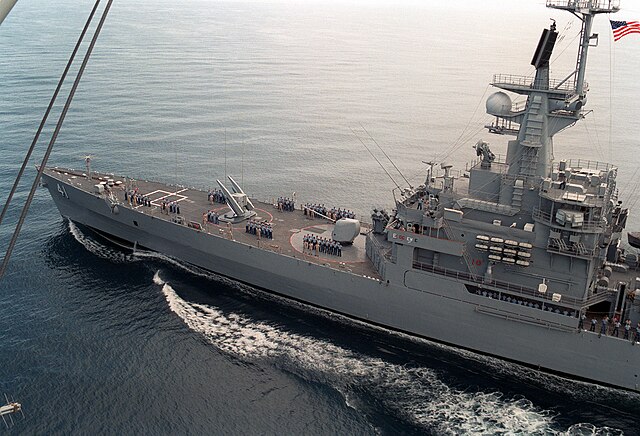
Forward deck view during a review on 9 April 1986.
In 1990 USS Arkansas started a counter-narcotic tour, west coast of Central America, Operation Vigilance boarding MV Nordkapp and seizing 14 tons of cocaine off Clipperton Island. The crew was sent to the US Coast Guard in San Diego and later convicted in federal court. In May 1991 she deployed in the Persian Gulf with Abraham Lincoln CBG carrier battle group, stopping en route to Subic Bay as Mount Pinatubo erupted in June and the Operation Fiery Vigil evacuations to Cebu from Clark AFB.
In 1996, she joined USS Carl Vinson CBG off Iraq for the Nautilus exercise and Operation Desert Strike.
In 1993 decision was made to cancel her mid-life refueling overhaul like her sisters. She was decommissioned on 7 July 1998, stricken, entering the Nuclear-Powered Ships Recycling Program.
 CGN-42
CGN-42

CSGN 1975 concept as of 1975
The unnamed fifth cruiser was designed as the first nuclear-powered AEGIS cruiser, a revised version of the CGN-42 strike cruiser. The process started as the CSGN (still under CGN 42) in 1975 and evolved in 1977. This proposal from DARPA of a guided missile attack cruiser displacing around 17,200 long tons (17,500 t) centered around the new Aegis combat system, SM-2, Harpoon, Tomahawk and new Mk71 8-inch large guns (another project to replace the Iowa class battleships big guns for coastal operations).
The prototype strike cruiser was to be the refurbished USS Long Beach under an optimistic $800 million refubishment program that was not approved by the Congress. Originally up to 12 strike cruisers were projected complemùented by anither AEGIS DDG-47 version of the Spruance-class destroyers but between design difficulties and rising cost its was canceled at the end of the Ford administration, then recast as a “simple” reconversion of the Virginia class, untiol cancelled again in 1983. In place the Spruance derivative was chosen as cheaper and became the Ticonderoga class (CG-47) Aegis cruiser program.
web.archive.org ship bucket profile
Read More/Src
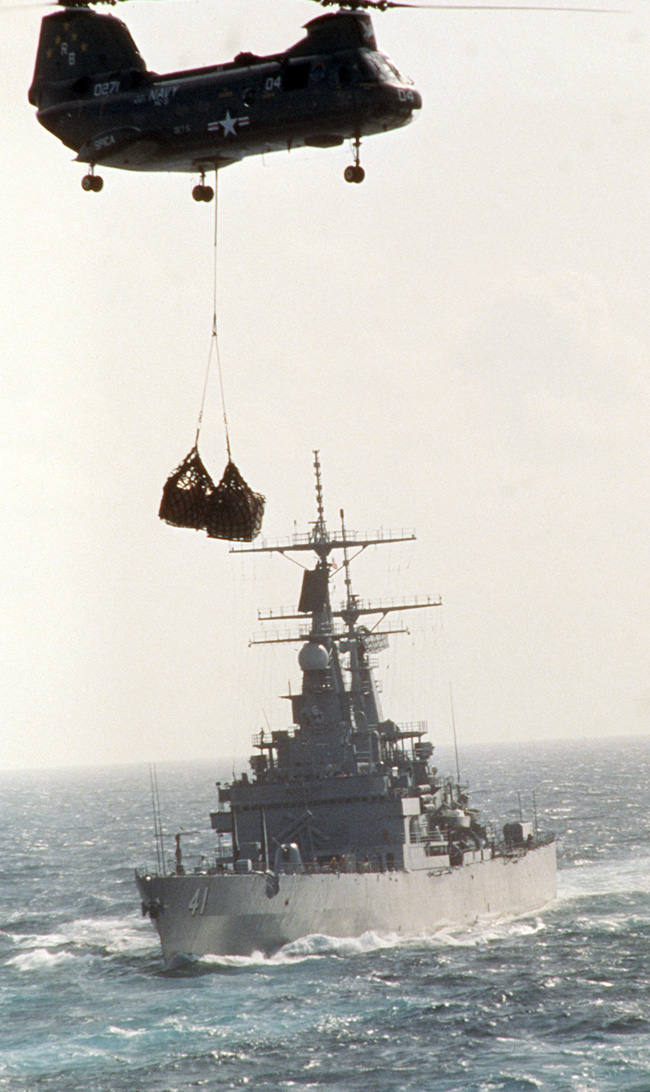
Books
jjjjjjjjjjjjjjjjjjjj
Links
navalanalyses.com
navy-matters.blogspot.com
globalsecurity.org/ cgn-42.htm
globalsecurity.org cgn-38.htm
globalsecurity.org cg-47-specs
navysite.de/ cgn38.htm
history.navy.mil/ virginia-v.html
seaforces.org/ Virginia-class.htm
man.fas.org/ cgn-38.htm
navsource.org/ 040138.htm
weaponsandwarfare.com
en.wikipedia.org/
commons.wikimedia.org
Videos
Model Kits
Main query on scalemates
USS Virginia CGN-38 Iron Shipwrights 1:350, USS Arkansas CGN-41 Cyber Hobby 1:700, USS Virginia CGN-38 Cyber Hobby 1:700, USS VIRGINIA (CGN-38) JAG 1:700
https://sdmodelmakers.com/virginia-class–cruiser-12-inch-model.html
3D

https://www.turbosquid.com/FullPreview/703811

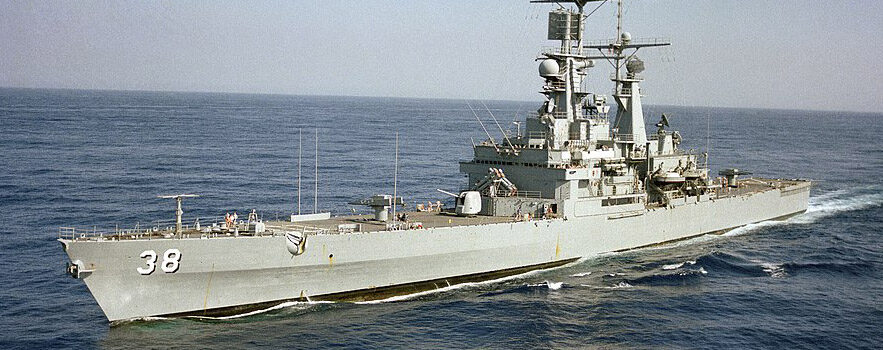
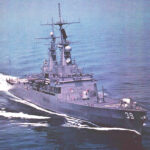
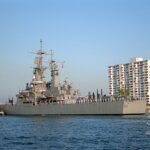
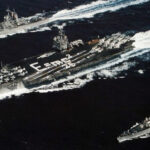
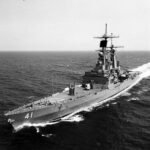
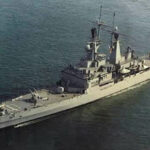
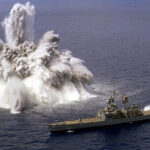
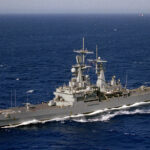
 Latest Facebook Entry -
Latest Facebook Entry -  X(Tweeter) Naval Encyclopedia's deck archive
X(Tweeter) Naval Encyclopedia's deck archive Instagram (@navalencyc)
Instagram (@navalencyc)





 French Navy
French Navy Royal Navy
Royal Navy Russian Navy
Russian Navy Armada Espanola
Armada Espanola Austrian Navy
Austrian Navy K.u.K. Kriegsmarine
K.u.K. Kriegsmarine Dansk Marine
Dansk Marine Nautiko Hellenon
Nautiko Hellenon Koninklije Marine 1870
Koninklije Marine 1870 Marinha do Brasil
Marinha do Brasil Osmanlı Donanması
Osmanlı Donanması Marina Do Peru
Marina Do Peru Marinha do Portugal
Marinha do Portugal Regia Marina 1870
Regia Marina 1870 Nihhon Kaigun 1870
Nihhon Kaigun 1870 Preußische Marine 1870
Preußische Marine 1870 Russkiy Flot 1870
Russkiy Flot 1870 Svenska marinen
Svenska marinen Søværnet
Søværnet Union Navy
Union Navy Confederate Navy
Confederate Navy Armada de Argentina
Armada de Argentina Imperial Chinese Navy
Imperial Chinese Navy Marinha do Portugal
Marinha do Portugal Mexico
Mexico Kaiserliche Marine
Kaiserliche Marine 1898 US Navy
1898 US Navy Sovietskiy Flot
Sovietskiy Flot Royal Canadian Navy
Royal Canadian Navy Royal Australian Navy
Royal Australian Navy RNZN Fleet
RNZN Fleet Chinese Navy 1937
Chinese Navy 1937 Kriegsmarine
Kriegsmarine Chilean Navy
Chilean Navy Danish Navy
Danish Navy Finnish Navy
Finnish Navy Hellenic Navy
Hellenic Navy Polish Navy
Polish Navy Romanian Navy
Romanian Navy Turkish Navy
Turkish Navy Royal Yugoslav Navy
Royal Yugoslav Navy Royal Thai Navy
Royal Thai Navy Minor Navies
Minor Navies Albania
Albania Austria
Austria Belgium
Belgium Columbia
Columbia Costa Rica
Costa Rica Cuba
Cuba Czechoslovakia
Czechoslovakia Dominican Republic
Dominican Republic Haiti
Haiti Hungary
Hungary Honduras
Honduras Estonia
Estonia Iceland
Iceland Eire
Eire Equador
Equador Iran
Iran Iraq
Iraq Latvia
Latvia Liberia
Liberia Lithuania
Lithuania Mandchukuo
Mandchukuo Morocco
Morocco Nicaragua
Nicaragua Persia
Persia San Salvador
San Salvador Sarawak
Sarawak Uruguay
Uruguay Venezuela
Venezuela Zanzibar
Zanzibar Warsaw Pact Navies
Warsaw Pact Navies Bulgaria
Bulgaria Hungary
Hungary

 Bundesmarine
Bundesmarine Dutch Navy
Dutch Navy Hellenic Navy
Hellenic Navy Marina Militare
Marina Militare Yugoslav Navy
Yugoslav Navy Chinese Navy
Chinese Navy Indian Navy
Indian Navy Indonesian Navy
Indonesian Navy JMSDF
JMSDF North Korean Navy
North Korean Navy Pakistani Navy
Pakistani Navy Philippines Navy
Philippines Navy ROKN
ROKN Rep. of Singapore Navy
Rep. of Singapore Navy Taiwanese Navy
Taiwanese Navy IDF Navy
IDF Navy Saudi Navy
Saudi Navy Royal New Zealand Navy
Royal New Zealand Navy Egyptian Navy
Egyptian Navy South African Navy
South African Navy






























 Ukrainian Navy
Ukrainian Navy dbodesign
dbodesign